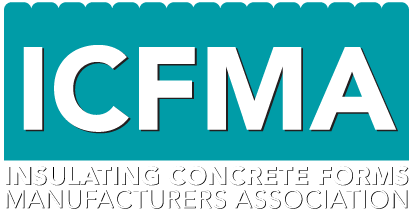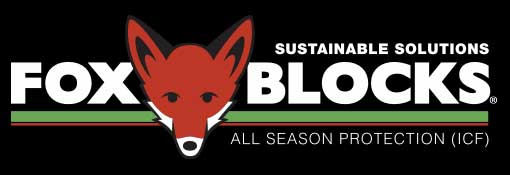ICFA Holds Annual Meeting
The Insulating Concrete Form Association is holding their Fall Meeting and Expo September 24-26, 2007, at the Hyatt Regency Hotel at Union Station in St. Louis, Mo.
The ICFA now holds its conventions on an annual basis; this is the only ICFA expo taking place this year. As part of the change, the ICFA will be offering ICF training opportunities for contractors. This year, they will be teaching the National Association of Home Builders (NAHB) Building with Insulating Concrete Forms course.
Fox Blocks Gets ICC Approval
Fox Blocks, a division of Airlite Plastics Company, announced that their Insulating Concrete Form (ICF) now has ICC code approval.
The code approvals mean Fox Blocks are an approved building product in most areas of the United States, and that building inspectors and code officials can feel confident that the product is approved.
The International Code Council (ICC) Evaluation Service issued the company ES Report No. 2270. The certificate can be viewed on both the Fox Blocks and ICC websites.
“Achieving ICC ES approval after being available nationwide for just 12 months represents a major commitment by Fox Blocks to gain significant market share in the ICF business and in particular the commercial construction sector,” says Dave Jackson, sales and marketing representative for the company.
Reward Purchases Tritex
Reward Wall Systems, Inc. has acquired Tritex ICF Products.
“We are very pleased to now have Tritex’s respected line
of products complementing our own,” said Reward President Edward Storm.
The companies had previously shared marketing and technical services, but this move consolidates all aspects of the two companies. The Xillix form, Tritex’s flagship product, is quite similar to Reward’s iForm, with the notable exception that the foam sidewalls of Xillix are considerably thinner (1 5/8” opposed to 2 ½” thick).
The acquisition will allow Reward to offer a larger range of products to broader customer base, and also gives the company some pricing flexibility for budget builders. Tritex customers will gain access to Reward’s customer support services, including technical and engineering assistance, marketing support, and onsite training.
PCA Researching SIP Roofs
Homes with ICF walls often use Structurally Insulated Panels (SIPs) as a roof system. The combination creates a high-performance, energy efficient home, but builders have been challenged by a lack of specifications for connecting these two products.
A new study hopes to resolve this. The U.S. Department of Housing and Urban Development (HUD) has funded a study to develop cost-effective prescriptive guidelines for connecting concrete walls to structural insulated panel roof systems. The research is being conducted by the NAHB Research Center, with technical support from the Portland Cement Association (PCA) and the Structural Insulated Panel Association (SIPA).
“The research will produce information that enables builders to reduce costs and improve the quality of the homes they build,” said Mike Weber, PCA’s director of residential promotion.
“The current lack of standards increases design costs and construction costs,” said William Wachtler, executive director of SIPA. “This study will allow for the formation of a cross-industry advisory committee to develop specific guidelines for builders and result in an extremely high-performance building envelope for homes.”
ICF Builder will publish an illustrated summary of the results when the study is completed in mid-2008.
Marketing Help for ICF Builders
The Portland Cement Association (PCA) has created a website to help concrete contractors and homebuilders to create marketing and advertising materials.
Called the “DIY Promotion Zone,” users can download samples and templates they can customize for their specific companies and events.
Templates include print ads, brochures, postcards, and e-mails.
PCA claims that, “The ‘DIY Promotion Zone’ offers a promoter of any size the ability to create marketing materials with professionally designed looks and messages.”
While there is no fee to view the materials, the site does charge for the files downloaded and for printing services.
The site can be visited at http://www.cement.org/homes/DIY/.
Logix Now Carries V-Buck
LOGIX Insulated Concrete Forms has reached an agreement with Vinyl Technologies Inc. to distribute their popular V-Buck window and door system through LOGIX’s national distribution network.
“This partnership is a great fit for our company,” says Bruce Anderson, vice-president of Vinyl Technologies. “We look forward to this enhanced relationship with LOGIX and its distributors.” Vinyl Technologies developed three new sizes of its bucking system to match the various LOGIX form units.
NRMCA Introduces SCC Brochure
The National Ready Mixed Concrete Association (NRMCA) has published a 4-page brochure, Self-Consolidating Concrete, designed to inform specifiers, engineers, contractors and their clients about the technology.
SCC, also known as self-compacting concrete, is a highly flowable, non-segregating concrete that will fill narrow formwork and congested steel reinforcement with no voids and with little or no mechanical vibration. SCC delivers these benefits while maintaining customary mechanical properties and durability characteristics. The brochure can be reviewed and ordered from NRMCA at www.nrmca.org/scc.
Residential Slowdown Continues
Despite large cutbacks in new residential construction and significant price reductions, the Portland Cement Association (PCA) reports the single-family market has not yet stabilized.
Chief Economist Ed Sullivan says the decline in residential construction will be deeper than expected, and that high inventory levels and sluggish sales continue to affect the market well into 2008.
“Even though single-family housing starts are nearly 30% lower than last year, the slow sales have diminished the builder’s ability to improve the inventory,” Sullivan says. “In addition, an expected doubling of the amount of homes entering foreclosure will put additional pressure on the inventory situation.”
Green is Hot While Market is Cool
The NAHB reports that while production housing continues its slump “green building and remodeling is one corner of the marketplace where demand is riding higher than the available supply.”
McGraw-Hill Construction says there “are not enough green builders
out there and demand is exceeding the homes available,” with the shortfall particularly pronounced in the East, said Harvey Bernstein, the company’s vice president of industry analytics, alliances and strategic initiatives.
Bernstein added that green housing is a differentiator from traditional homes and “something still in demand” even during the current market correction.
NAHB’s vice president of research states that energy-efficiency is now a primary concern of home buyers, as the cost of energy remains high and homes are 50% larger than 30 years ago. He adds that survey and focus group research makes it “loud and clear” that buyers are willing to spend a little bit more to improve energy efficiency because this is an issue that “hits the pocketbook.”
According to McGraw Hill Construction, prospective buyers are hearing about green homes mostly by word of mouth (28%) and from television shows (20%).
LEED Standards Tightened
The U.S. Green Building Council (USGBC) has revised their LEED standard upwards, requiring 2 additional “Optimize Energy Performance” points. This will improve the energy performance of all new LEED-certified buildings by 14%.
Commercial ICF construction should have few problems qualifying for the additional points, which usually requires an Energy Star rating. The new standards took effect earlier this summer. A complete explanation of the criteria is available at http://www.usgbc.org/ShowFile.aspx?DocumentID=2303.







v.3.jpg)









